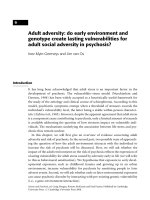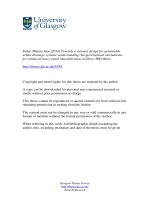Integrated forward and reverse logistics network design for third party logistics providers
Bạn đang xem bản rút gọn của tài liệu. Xem và tải ngay bản đầy đủ của tài liệu tại đây (709.45 KB, 91 trang )
INTEGRATED FORWARD AND REVERSE LOGISTICS
NETWORK DESIGN FOR THIRD PARTY LOGISTICS
PROVIDERS
BIAN WEN
NATIONAL UNIVERSITY OF SINGAPORE
2006
INTEGRATED FORWARD AND REVERSE LOGISTICS
NETWORK DESIGN FOR THIRD PARTY LOGISTICS
PROVIDERS
BIAN WEN
( B.Eng., Tsinghua University )
A THESIS SUBMITTED
FOR THE DEGREE OF MASTER OF ENGINEERING
DEPARTMENT OF CIVIL ENGINEERING
NATIONAL UNIVERSITY OF SINGAPORE
2006
ACKNOWLEDGEMENT
Upon the completion of this thesis, I would like to express my deep gratitude and grateful
thanks to my supervisor, Associate Professor Lee Der-Horng for his invaluable guidance,
constructive discussion and suggestion throughout this research work. I am indebted to
Assistant Professor Meng Qiang for his great encouragement and inspiration on both my
academic research and personal life.
I would also like to thank our laboratory officer, Mr. C.K.Foo for his kind assistance.
Particularly, thanks also are extended to my colleagues in the ITVS Lab, Dong Meng,
Wang Huiqiu, Huang Yikai, Cao Zhi, Cheng Shihua, Lucile Garot, Alvina Kek Geok and
Khoo Hooi Ling, Huang Yongxi, Deng Weijia, for their care, encouragement and share
of happiness.
Special thanks go to National University of Singapore for providing me with the research
scholarship covering the entire period of my graduate studies.
I wish to record my thanks and gratitude to all those who have assisted me directly and
indirectly in carrying out this research work.
Finally, the most sincere gratitude is due to my parents for their love, support and
encouragement that help me get through the difficult times.
i
TABLE OF CONTENTS
ACKNOWLEDGEMENT ............................................................................................... I
TABLE OF CONTENTS ................................................................................................ II
SUMMARY.................................................................................................................... V
LIST OF FIGURES....................................................................................................... VII
LIST OF TABLES ....................................................................................................... VIII
CHAPTER 1 INTRODUCTION..................................................................................... 1
1.1
RESEARCH BACKGROUND........................................................................... 1
1.2
RESEARCH SCOPE .......................................................................................... 5
1.3
ORGANIZATION OF RESEARCH .................................................................. 5
CHAPTER 2 LITERATURE REVIEW ........................................................................ 8
2.1
REVERSE DISTRIBUTION NETWORK DESIGN.......................................... 8
2.1.1
Strategic Points in the Design of Reverse Supply Chain Network................. 9
2.1.2
Reverse Logistics Network Structure and Corresponding Models............... 11
2.2
OUTSOURCING REVERSE DISTRIBUTION TO THE 3PLS ...................... 14
2.2.1
Reasons of Outsourcing ................................................................................ 15
2.2.2
Advantage of 3PLs........................................................................................ 16
2.2.3
Models of Reverse Distribution for 3PLs ..................................................... 17
2.3
SUMMARY...................................................................................................... 18
ii
CHAPTER 3 A MULTI-OBJECTIVE MODEL AND SOLUTION METHOD FOR
INTEGRATED LOGISTICS NETWORK DESIGN .................................................. 20
3.1
INTRODUCTION ............................................................................................ 20
3.2
MODEL DEVELOPMENT .............................................................................. 22
3.2.1
Notations ....................................................................................................... 23
3.2.2
Model Formulation ....................................................................................... 25
3.3
SOLUTION APPROACH ................................................................................ 28
3.3.1
Single Objective Transformation.................................................................. 28
3.3.2
A Genetic Algorithm..................................................................................... 31
3.4
COMPUTATIONAL RESULTS...................................................................... 40
3.4.1
Experiment Design........................................................................................ 40
3.4.2
Experiment Results ....................................................................................... 42
3.4.3
Sensitivity Analysis of the Acceptable Distance to the Model Solution ...... 46
3.5
CONCLUSIONS............................................................................................... 47
CHAPTER 4 MULTIPRODUCT DISTRIBUTION NETWORK DESIGN ............ 48
4.1
INTRODUCTION ............................................................................................ 48
4.2
MODEL DEVELOPMENT .............................................................................. 50
4.2.1
Notations ....................................................................................................... 50
4.2.2
Model Formulation ....................................................................................... 52
4.3
SOLUTION APPROACH ................................................................................ 53
4.3.1
Genetic Representation ................................................................................. 54
4.3.2
Initial Population........................................................................................... 54
iii
4.3.3
Genetic Operators ......................................................................................... 55
4.3.4
Evaluation ..................................................................................................... 57
4.3.5
Selection........................................................................................................ 59
4.3.6
The Genetic Algorithm Procedure ................................................................ 60
4.4
COMPUTATIONAL RESULTS...................................................................... 63
4.4.1
Experiment Design........................................................................................ 63
4.4.2
Experiment Results ....................................................................................... 66
4.4.3
Sensitivity Analysis of Return Rates ............................................................ 69
4.5
CONCLUSIONS............................................................................................... 70
CHAPTER 5 CONCLUSION AND RECOMMENDATION .................................... 72
5.1
SUMMERY OF THE RESEARCH.................................................................. 72
5.2
SIGNIFICANCE AND HIGHLIGHTS OF THE RESEARCH ....................... 73
5.3
FUTURE WORK RECOMMENDATION ...................................................... 73
REFERENCES................................................................................................................ 75
iv
SUMMARY
Stimulated by the environmental, economic and commercial concerns, reverse logistics,
refers to the distribution activities involved in product returns, has recently received
growing attention. Nonetheless, reverse logistics is actually very involved and can be
extremely complex. Many companies with limited resources and knowledge of reverse
logistics are incapable or unwilling to enter the reverse logistics market. Furthermore, the
increasing opportunities for cost savings and customer satisfaction have prompted third
party logistics providers (3PLs) to get involved in the forward and reverse logistics
operations. Accordingly, more and more companies are increasingly outsourcing their
distribution operations to the third party logistics providers
Due to the difference and interaction between the forward and reverse distributions, how
to integrate the forward and reverse channels has become an emerging issue. In the past,
there are very few researches treating forward and reverse distribution simultaneously for
the 3PLs. In fact, the integration of forward and reverse distribution and the locations of
hybrid facilities for both forward and reverse networks need to be considered especially
at the stage of distribution network design. On the other hand, the distribution network
operated by the 3PLs is also involved in the multi-objective treatment which explicitly
analyzes the tradeoff between cost and customer satisfaction. Moreover, different from
other distribution network, the distribution network operated by the 3PLs not only
considers the type and quantity of customer products demands but also the corresponding
clients that customers are served. Another key issue involved is the efficient solution
v
method for such problems. Due to the complexity of the problem and the large number of
variables and constraints, the use of conventional linear programming tools to obtain
solutions is limited.
In this research, two models for the integrated network design for 3PLs are proposed. The
first one is a multi-objective optimization model. Two objectives are considered in this
proposed model: (1) maximization of the returned products shipped from customers back
to the collection facilities; and (2) minimization of the total cost associated with the
forward and reverse logistics operations. Fuzzy goal programming (FGP) approach is
applied to determine the compromise solution for the multi-objective model. The second
one is proposed for the multiproduct network design problem considering activities of
3PLs for forward and reverse distributions simultaneously.
To solve the proposed models, the genetic algorithm (GA) with different greedy
algorithms is used to obtain the location of facilities and the product forward and reverse
flows. Numerical experiments are presented to demonstrate the applicability of the
formulated models and the solution approaches.
Finally, in view of the research work so far has been conducted, the future work is
depicted and pictured.
Keywords: Reverse logistics; Third party logistics providers; Integrated network design;
Multi-objective; Multiproduct; Genetic algorithm; Greedy algorithm.
vi
LIST OF FIGURES
Figure 3.1 A Depiction of an Integrated Forward and Reverse Logistics Network
Structure.................................................................................................................... 22
Figure 3.2 Linear Membership Function of the Fuzzy Goals of the Proposed Problem .. 30
Figure 3.3 An Illustration of the Chromosome Representation........................................ 32
Figure 3.4 One-cut Point Crossover Methods................................................................... 32
Figure 3.5 The Flowchart of the Proposed Genetic Algorithm ........................................ 39
Figure 4.1 A Depiction of an Integrated Logistics Network Structure for 3PLs.............. 49
Figure 4.2 A Genetic Representation Scheme of Chromosome ....................................... 54
Figure 4.3 Repair Strategy for Insufficient Forward Capacity ......................................... 57
Figure 4.4 Repair Strategy for Insufficient Reverse Capacity.......................................... 57
Figure 4.5 Flowchart of the Proposed GA ........................................................................ 62
Figure 4.6 Data Generation for the Different Types of Product Demand of Customer.... 65
Figure 4.7 The Gaps Between the Feasible Solutions and the Optimal Solutions ........... 68
Figure 4.8 The Comparison of Computational Time Between the Proposed GA and
CPLEX...................................................................................................................... 69
Figure 4.9 Results with Different Level of Return Rates ................................................. 70
vii
LIST OF TABLES
Table 3.1 Ten Randomly Generated Problems ................................................................. 40
Table 3.2 The Results of the Test Problems for Obtaining the Aspiration Level of the
Second Objective ( g 2 ).............................................................................................. 43
Table 3.3 The Results of the Test Problems for Getting Optimal Value of the
Transformed Model (T) ............................................................................................ 45
Table 3.4 A Sensitivity Analysis with Varying Acceptable Distance .............................. 46
Table 4.1 Generated Problem Sets of Integrated Distribution.......................................... 63
Table 4.2 The Results of the Test Problem....................................................................... 67
viii
CHAPTER 1: INTRODUCTION
CHAPTER 1
1.1
INTRODUCTION
RESEARCH BACKGROUND
Reverse logistics is the process of planning, implementing, and controlling the efficient,
cost effective flow of raw materials, in-process inventory, finished goods and related
information from the point of consumption to the point of origin for the purpose of
recapturing value or proper disposal. More precisely, reverse logistics is the process of
moving goods from their typical final destination for the purpose of capturing value, or
proper disposal (Rogers, 1998). Reverse logistics encompasses the logistics activities all
the way from used products no longer required by the user to products again usable in a
market. Remanufacturing and refurbishing activities also may be included in the
definition of reverse logistics.
Products may be in the reverse direction in the supply chain for a variety of reasons
which include: manufacturing returns; commercial returns; product recalls; warranty
returns; service returns; end-of-use returns and end-of-life returns. Manufacturing returns
mean that the components or products have to be recovered in the production phase due
to unsatisfactory quality or production leftovers. Commercial returns are all those returns
where a buyer has a contractual option to return products to the seller. B2C (Business to
Customer) commercial returns often occur in the business-to-consumer scenery, in which
products may be sent back due to mismatches in demand and supply in terms of timing or
product quality. Product recalls mean that the defective products will be recollected after
they have entered the supply chain. Warranty returns mean that the sold products which
1
CHAPTER 1: INTRODUCTION
do not meet the promised quality standards will be returned by customers. In a situation
that the warranty period has expired, the returns of products from customers for
maintenance or repair service are defined as service returns. Ultimately, even after use or
product life, the collection of products to be remanufactured, recycled or incinerated are
referred to end-of-use and end-of-life returns.
Traditionally, companies merely considered the forward supply chain in their commercial
operations but did not realize the responsibility of taking care their products after the
product life spans. Lately, due to the new waste management legislation such as Basel
Convention (Basel Convention official website, 2006), the operations of used–product
recovery have attracted more attentions. Meanwhile, due to the high costs and
environmental burdens of disposal of used-products, more and more companies have
taken up the collection, dismantling and upgrading of used products and packaging
materials (Revlog, 2005). Reverse logistics is an excellent strategic source of value added
revenues. The following economical and practical justifications highlight the necessity of
investment in the reverse logistics. In the United States, the remanufactured auto parts
market was estimated to be $36 billion in 1998 (APRA, 1998). In 1999, the total value of
returned merchandise was $62 billion, while the cost of handling these product returns
was estimated to be $40 billion (ReturnBuy, 2000).
While recognizing the importance of reverse logistics operations, many companies take
the reverse flows into account to get more profit, to avoid any waste and even to benefit
the customer relationship. However, the reverse logistics operations and the reverse
2
CHAPTER 1: INTRODUCTION
supply chains are much more complicated than traditional manufacturing supply chains
(Dennis and Kambil, 2003). Many companies currently have inefficient, slow and
expensive processes for handling returned products. They are either incapable or
unwilling to enter the reverse logistics market. Considerable value is lost when reverse
logistics activities are not processed quickly and completely. Therefore, more and more
companies outsource the reverse logistics operations to the third party logistics providers
(3PLs). For example, in the United States, the market for 3PLs was estimated at more
than $45 billion in 1999 and is growing by nearly 18% annually (Ko and Evans, 2005). In
addition, 74% of Fortune 500 companies used 3PLs’ services during 2000. These services
involved transportation management, freight payment, warehouse management, shipment
tracking, and reverse logistics (Ko and Evans, 2005). The main advantage of outsourcing
reverse logistics to the 3PLs can be described as follows. The 3PLs have sufficient tools
or systems to assist in controlling forward distributions effectively, as such, reverse
logistics is an intuitive extension of the existing business scope of the 3PLs and it is not
necessary to interrupt the existing forward flows. Accordingly, the 3PLs are ideally suited
in handling reverse logistics and cost savings.
At present, many companies often handle the reverse distribution through the original
forward channel. In fact, the reverse logistics has big difference with forward logistics.
For instance, since the returning product is not in “new” condition, additional verification
must be performed at receiving to ensure the expected product from a customer matches
the actual received product. Furthermore, many returned items just require basic testing
and repackaging and some units require more advanced repair work. The units are
3
CHAPTER 1: INTRODUCTION
streamed back to the original manufacturer or to a service center for repair. As such,
using the original forward channel is not appropriate to reverse logistics. To design a new
reverse channel becomes a key issue for both the researchers and the companies. Ko and
Park (2005) illustrated that integrated network considering forward and reverse
distribution simultaneously provided more effective solution than treating forward and
reverse distribution separately.
However, there are very few models treating forward and reverse distribution
simultaneously. Most existing researches only focus on the separate reverse distribution
problem in which the interaction between the distribution of forward products and
returned products is ignored. In fact, the integration of forward and reverse distribution
and the locations of hybrid facilities for both forward and reverse networks need to be
considered at the stage of distribution network design. Especially for the 3PLs which
always manage the forward and reverse operations for a number of different clients,
combining the forward and reverse flows will give them more competitive advantages
with respect to cost and revenue.
Furthermore, the characteristics of the 3PLs also should be taken into account in the
research work. Firstly, the distribution operations of the 3PLs often enters into the
tradeoff between cost saving and customer satisfaction. Given a fixed level of operation
cost, the more customers the 3PLs serve, the more potential benefits they gain. Such
potential benefits are usually derived from an enhancement of their corporate image,
which commonly can not be evaluated by money. Secondly, the 3PLs usually serve
4
CHAPTER 1: INTRODUCTION
different clients and each client has their own customers, the demand of these customers
can only be satisfied by the specific clients although different clients may have same
types of products.
Another key issue involved is the efficient solution method for such problems. Due to the
complexity of the problem and the large number of variables and constraints, the use of
conventional linear programming tools to obtain solutions is very limited. The
development of efficient algorithm is necessary for the research work in this field.
1.2
RESEARCH SCOPE
Research on the integrated distribution network design revolves around managing the
interaction between the forward and reverse distribution. Key concerns which invariably
surface are the locations of facilities for operations of both forward and reverse logistics,
as well as the distribution of forward and returned products. This study addresses two
integrated forward and reverse distributions network design problems for the 3PLs that
are under different scenarios according to the characteristic of the 3PLs. The research
scope for this study comprises of the following segments.
z
Model development for the integrated network design of the 3PLs.
z
Develop heuristic method to deal with the large-scale network problems.
1.3
ORGANIZATION OF RESEARCH
There are totally five chapters in this research.
5
CHAPTER 1: INTRODUCTION
Chapter 1 is the introductory chapter which is made up of three sections – research
background, research scope and organization of research.
Chapter 2 is the literature review chapter, which presents and summarizes the past
research work related to the major components of this research – reverse distribution
network design and outsourcing the reverse distribution to the 3PLs.
Chapter 3 develops a multi-objective model considering activities of the 3PLs for forward
and reverse distributions simultaneously. Two objectives are included in the proposed
model: (1) maximization of the returned products shipped from customers back to the
collection facilities; and (2) minimization of the total costs associated with the forward
and reverse logistics operations. Fuzzy goal programming (FGP) approach is applied to
determine the compromise solution for the multi-objective model. A genetic algorithm
(GA) with two sub-algorithms is developed to solve the problem. Numerical experiments
are presented to demonstrate the applicability of the formulated model and the solution
method.
Chapter 4 addresses an integrated forward and reverse distributions network design
problem for the 3PLs that involves locating distribution facilities such as warehouse,
collection center and hybrid warehouse-collection center, and determining the strategy
for distributing the multiple products between the clients of the 3PLs and the customers
via distribution facilities. A genetic algorithm (GA) with two greedy algorithms is used
for solution purpose. Computational experiments demonstrate a great deal of promise for
6
CHAPTER 1: INTRODUCTION
this solution method, as high-quality solutions are obtained while expending modest
computational effort.
Chapter 5 concludes this research, and provides some recommendations for future
research.
7
CHAPTER 2: LITERATURE REVIEW
CHAPTER 2
LITERATURE REVIEW
This chapter provides a review of academic literature related to the field of the present
investigation. Some useful enlightenment for this research is also got from the review and
the analysis to these outputs.
2.1
REVERSE DISTRIBUTION NETWORK DESIGN
Vandermerwe and Oliff (1991) provided a systematic analysis of the business
implications of product recovery which is among the earliest influential contributions to
reverse logistics network design. Stock (1992) firstly recognized the field of reverse
logistics as being relevant for business and society and gave the definition of “reverse
logistics”. Kopicki et al. (1993) investigated the discipline and practice of reverse
logistics, pointing out the opportunities on reuse and recycling. Sarkis et al. (1995)
depicted three important characteristics that differentiate a reverse distribution system
from a forward distribution system. Firstly, most logistics systems are not equipped to
handle product movement in a reverse channel. Secondly, the reverse distribution cost
may be higher than moving the original product from the manufacturing site to the
customer due to the smaller batch size. Thirdly, returned products often cannot be
transported, stored, or handled in the same manner as in regular channel. Therefore,
modifications and extensions of traditional network design models are required.
8
CHAPTER 2: LITERATURE REVIEW
2.1.1
Strategic Points in the Design of Reverse Supply Chain Network
Reverse logistics is an excellent strategic source of value added revenues. During the last
decade, reverse logistics has received increasing recognition from both academic
researchers and industrial practitioners. The location of production facilities, storage
concepts, and transportation strategies are major determinants of supply chain
performance. Reverse logistics should also be taken into account during the design of the
support network such as location and capacity of warehouses, plants, choice of
outsourcing vendors, distribution channel and supporting technology. Returns
information captured should be integrated with forward supply chain information to
achieve optimum planning and reduction of costs. The whole support network can then
be designed in such a way that it can service both the forward and reverse logistics
processes efficiently. This is in line with the concept of a closed-loop supply chain design.
Rakesh and Vinayak (2005) summarized four strategic points in the design of reverse
supply chain network which are elaborated as follows.
•
Acquisition/collection of returned/used products
Managing the collection and acquisition of used or returned products potentially accounts
for a significant part of the total costs of any closed-loop supply chain. To design the
network for collection a company can install several drop points for customers to hand in
used products, integrate the reverse flow of used products with other transportation flows
or use a direct express mail system to bypass several stages of the network for fast
processing. The type of design depends on different product types and needs of the
customers. Retailers and distributors are often used as the points of collection.
9
CHAPTER 2: LITERATURE REVIEW
•
Testing/grading operations
The location of the test and grade operations in the network has an important impact on
the flow of goods. It is only after this stage that individual products can be assigned to an
appropriate recovery option and hence to a geographical destination. It is important to see
a tradeoff between transportation and investment costs at this stage. Testing collected
products early in the channel may minimize total transportation distance since graded
products can directly be sent to the corresponding recovery operation. On the other hand,
expensive test equipment and the need for skilled labor act as drivers for centralizing the
test and grade operations.
•
Reprocessing
The reprocessing generally requires high investments in establishing the network for
reverse logistics. The costs for specialized remanufacturing or recycling equipment
influence the economic viability of reprocessing. Integration of product recovery
operations with the original manufacturing process can offer economies of scale which
involves sharing of locations, workforce, or even manufacturing lines.
•
Redistribution
Redistribution stage resembles a traditional distribution network. In particular, we find
the conventional tradeoff between consolidation and responsiveness in transportation. If
collection and redistribution are combined we can achieve efficiencies in vehicle loading.
Redistribution can also be done along with distribution of new products.
10
CHAPTER 2: LITERATURE REVIEW
2.1.2
Reverse Logistics Network Structure and Corresponding Models
A main activity in reverse logistics is the collection of the products to be recovered and
the redistribution of the processed goods. The reverse logistics network can be classified
according to the type of recovery, re-usable, remanufacturing and recycling, which was
introduced by Fleischmann (2001).
•
Recycling networks
The recycling networks concerned with material recovery from rather low value products.
The investment costs turn out to be very substantial in this kind of network, due to
advanced technological equipment required. Moreover, recycling networks tend to be
highly vulnerable to uncertainty concerning the supply volume.
Caruso et al. (1993) described a solid waste management system, including collection,
transportation, incineration, composting, recycling and disposal. A multi-objective
location allocation model and some heuristics were used to plan the waste management
system. The procedure resulted in the number and locations of waste disposal plants,
specification of the technology adopted, and the amount of waste processed.
Barros et al. (1998) presented a network for the recycling of sand from construction
waste. Two types of intermediate facilities had to be located. Regional depots received
sand from companies sorting stone materials, tested its pollution level, and stored clean
sand. Specialized treatment facilities received the polluted sand for cleaning and
subsequent storage. Both types of facilities then provided sand to large scale road
11
CHAPTER 2: LITERATURE REVIEW
construction projects. The model was a multi-level capacitated warehouse location model.
Scenario analysis was used to cater for uncertainty in location of the demand points and
in the return flows.
Spengler et al. (1997) developed a mixed-integer linear programming model for recycling
of industrial byproducts which was applied to the German steel industry. Steel companies
needed to decide which recycling process or process chains were favorable from an
economic point of view. Moreover, they needed to verify cooperation possibilities, decide
on the capacities of recycling plants and on their location-allocation. The model is based
on the multi-level capacitated warehouse location problem modified for this special
problem structure.
•
Remanufacturing networks
Traditional examples of product being remanufactured include mechanical equipment
such as machine tools and engines, and spare parts in the automotive and aircraft industry.
More recently, remanufacturing of electronic equipment such as copy machines and
computer subassemblies is becoming an important area (Speranze and Stähly, 2000). The
remanufacturing networks concerned with re-use on a product or parts level of relatively
high value assembled products. Recovery is mainly carried out by the OEM (original
product manufactory), and re-use and original use often coincide.
Jayaraman et al. (1999) developed a closed-loop logistics system for recoverable product
environment. This environment is characterized by both the forward flow of
12
CHAPTER 2: LITERATURE REVIEW
remanufactures products to the customers, and the reverse flow of used products from the
customers to the recoverable manufacturing system. The authors present a 0-1 mixed
integer programming model that simultaneously solves for the location of
remanufacturing/distribution facilities, the transshipment, production, and stocking of
optimal quantities of remanufactured products. This model has been shown to be an
effective tool in the design of the closed-loop logistics system using a set of test problems
that grounded with industrial data.
Krikke et al. (1999) discussed a business case study that the remanufacturing of
photocopiers carried out at Oce. The authors considered two options for the
remanufacturing facility, one coinciding with the manufacturing facility and one in a
cheap labor country. They evaluate the costs of both options, including the transportation
effects. In addition, they discussed aspects regarding specific modeling elements in this
case situation, the definition of cost functions, the possibility of optimizing the forward
and reverse logistic network and the use of LP versus MILP models in this kind of
situations.
Lu and Bostel (2005) presented a two-level facility location model for the reverse
logistics systems covering remanufacturing activities, in which both direct and reverse
flows were considered simultaneously. An algorithm based on Lagrangian heuristics is
developed and the model is tested on data adapted from classical test problems.
•
Re-usable networks
13
CHAPTER 2: LITERATURE REVIEW
Re-usable items requiring only minor “reprocessing” steps such as cleaning and
inspection can be expected to lead to a rather flat network structure comprising a small
number of levels.
Kroon and Vrijens (1995) presented a return logistics system for returnable containers
which was developed in a case study for a logistics service organization in Netherlands.
The system was concerned with the transportation, maintenance, and storage of empty
containers. A classical plant location model was formulated to analyze the number of
containers, the number of depots and their locations.
2.2
OUTSOURCING REVERSE DISTRIBUTION TO THE 3PLS
Reverse logistics responsibility can be retained within the company or outsourced to the
3PLs. On the one hand, a manufacturing company may decide to carry out all recovery
activities concerning its products in-house. In this way product specific knowledge and
control may be kept within the organization. However, return flow volumes may be
critical to justify investments in recovery equipment and specialized expertise may be
required. On the other hand, all recovery activities may be outsourced if re-use,
remanufacturing, and recycling are not perceived as a company’s core-activities.
Outsourcing appears appropriate, in particular, in case of material recycling and small
and variable return flows. In this case, benefits from economies of scales can be expected
from centralized processing of higher volumes (Speranze and Stähly, 2000). Recently,
more and more companies are outsourcing most or all of their logistics activities to the
third party logistics providers, especially reverse logistics activities. In general, the 3PLs
14
CHAPTER 2: LITERATURE REVIEW
often perform reverse activities better, and their customers find that using the 3PLs will
reduce the administrative hassle of doing it themselves. As such, the 3PLs have become
specialists in managing the reverse flow, and performing key value-added services, such
as remanufacturing and refurbishing.
2.2.1
Reasons of Outsourcing
Nowadays, more and more retailers and manufacturers struggling with returns tend to
outsource the reverse activities. Reverse Logistics Professional (2005) provided the
following eight reasons for such outsourcing.
•
It is a small part of their business processes.
•
Their focus is getting new products to customers.
•
They have difficulty understanding and controlling costs.
•
There is poor or no systems for managing the returns processes.
•
A lack of systems results in slow processing of the returns and the returned inventory.
•
Inability to track or monitor inventory levels of returned stock.
•
Few good channels exist to get value from their returned and processed units.
•
Returns can be a significant problem if not managed well. Without good systems in
place significant individual attention is often required to manage a single return to
competition.
15









![gherghina et al - 2014 - a study on the relationship between cgr and company value - empirical evidence for s&p [cgs-iss]](https://media.store123doc.com/images/document/2015_01/02/medium_JKXoRwVO1T.jpg)